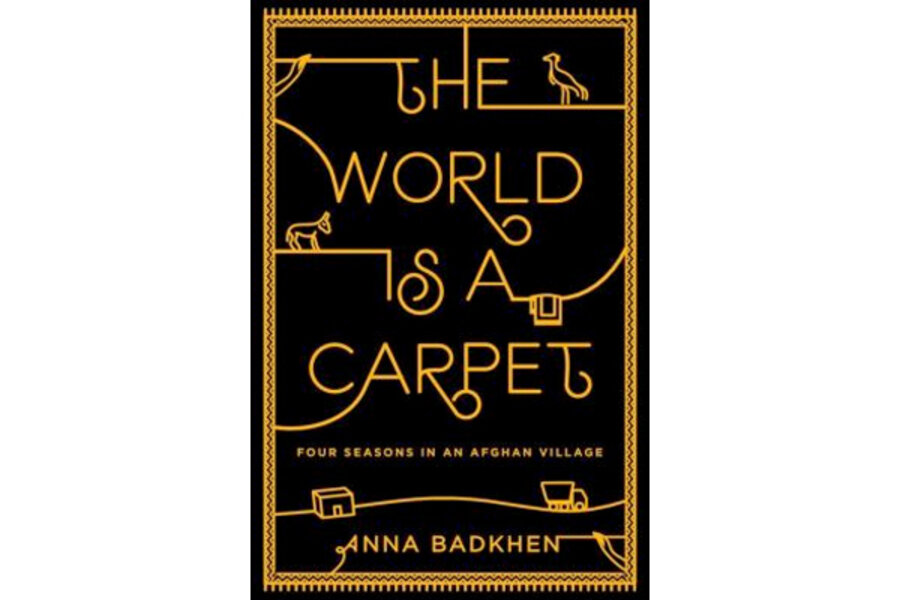The World Is a Carpet
Loading...
When you Google journalist Anna Badkhen, the one repeating line you’ll encounter is this: “Anna Badkhen writes about people in extremis.” To do so, she’s “spent [her] adult life in motion of one sort or another in the war-wrecked hinterlands of Central Asia, Arabia, Africa.”
Badkhen professes, “I did not have a home,” although she’s been making prolonged journeys to Afghanistan with regularity. Her fascination with the country – and her sojourns there – began “before American warplanes dropped their first payload on Kabul in 2001.” Her latest extended residency finds her based in the northern Afghan city of Mazar-e-Sharif, prompted in 2010 by a visit one afternoon to the tiny neighboring village of Oqa.
Populated by “forty doorless huts” and 240 residents, Oqa does not appear on any map; no roads connect the village to any other. Officials in Mazar-e-Sharif insist that Oqa does not exist. But Badkhen knows otherwise. Oqa is the place where she witnessed the creation of “the most beautiful carpet I have ever seen.”
It is that experience – blended with Badkhen’s account of the cultural and political landscape of a people and region in extremis – that forms the basis of her transporting new book, The World Is a Carpet: Four Seasons in an Afghan Village.
Commuting from a working-class neighborhood in Mazar-e-Sharif, Badkhen became a frequent visitor to the home of septuagenarian Oqan patriarch Baba Nazar; his wife, Boston (Turkoman for “garden”); his son; daughter-in-law; and their two young children. The Nazar family are Turkomans – members of the Afghan ethnic group known for their remarkable skills in carpetmaking.
In the case of the Nazar family, their survival hinges on the deft fingers of daughter-in-law Thawra, who spends seven months out of every year “squat[ting] on top of a horizontal loom built with two rusty lengths of iron pipe, cinder blocks, and sticks” to weave a single annual carpet.
The necessary wool costs just over $60; the carpet will sell for $200 to a dealer who will send it out in the world where a wealthy consumer (perhaps in the United States, which is “the single largest purchaser of carpets on the world market at the time of this story”), will pay somewhere between $5,000 and $20,000.
“Wherever her carpet ends up, for her work Thawra will be paid less than a dollar a day,” notes Badkhen. That precious payment will need to last the family another year, until Thawra’s overworked body begins the creation process once again.
“Of all the Afghan carpets, those woven by the Turkomans are the most valued,” Badkhen explains. In Afghanistan, carpets remain big business. “[A] million Afghans,” writes Badkhen, “one out of thirty – were believed to be weaving, buying, and selling carpets.”
In Oqa, where remoteness offers only illusory reprieve from the latest marauders – government militia, warlords, Taliban – Badkhen cannot safely stay even a single night.
Life here is often cruel. In Baba Nazar’s own family, his daughter – mangled as a teenager by a land mine that left her, most important, unable to weave – had no choice but to marry an elderly and nearly toothless sharecropper. Baba Nazar’s son, like most of Oqa’s men, dreams of escape, yet lacks the means to do anything but survive another day.
Circumscribed daily by deprivation, men and women use readily available opium as a substitute salve because “[f]ood … could cost five times as much.” It is not uncommon for infants to die of overdoses. Only Baba Nazar seems to know enough to forbid its use in his own family.
And yet even in this harshest of environments, Badkhen is able to capture kinship, laughter, and merriment, especially among the women. She tells their stories with an exacting vocabulary (her prose is dense with evocative words like filamentous cirri, sibilated, alluvial, and eldritch).
Beyond her words, Badkhen includes her own ambient sketches that capture the villagers’ daily lives; the active curiosity her drawing initially aroused eventually gives her the opportunity to become an invisible observer. Badkhen was able to watch village women take companionable turns in sharing Thawra’s work (“[i]t took a village to weave a carpet”), giggle over bawdy jokes in the kitchen, and indulge in joyous women-only revelry during wedding festivities.
These are the daily details that each woman works into a carpet: “her future autobiography, her diary of a year, her winter count, with its sorrowful zigzags, its daydreamy curlicues, loops of melancholy, knots of joy.”
At the risk of spouting clichés (but don’t they become such because of the universal truths buried within?), Badkhen weaves her own literary magic. For now, the stories of these women (and men and children) will travel to places that none of them could even imagine, to places, ironically, that many of their carpets already call home.
Terry Hong writes BookDragon, a book review blog for the Smithsonian Asian Pacific American Center.








